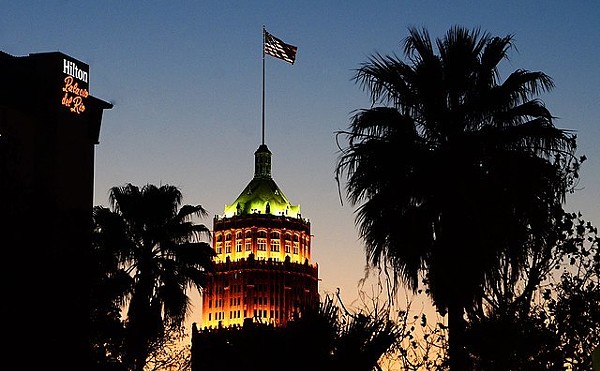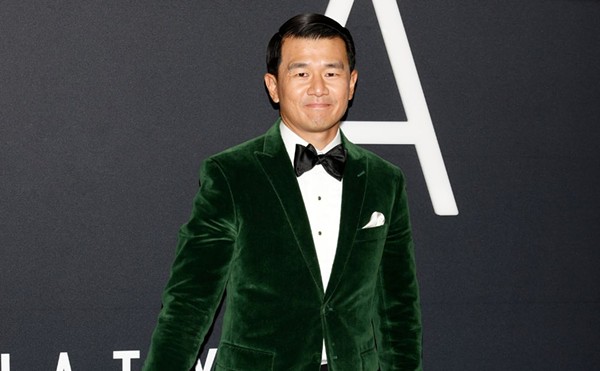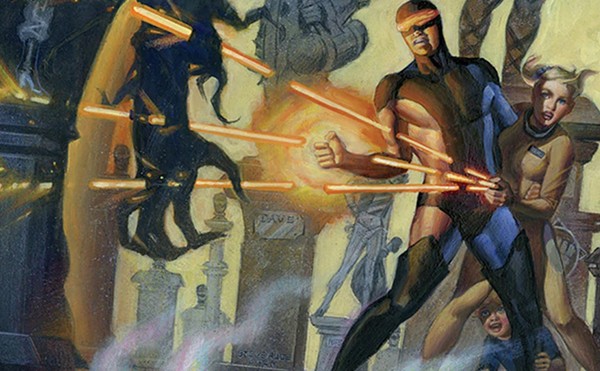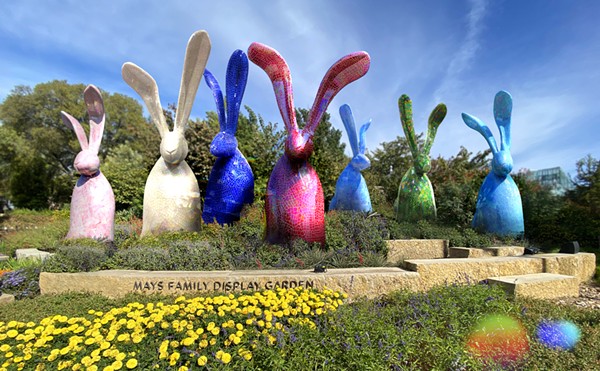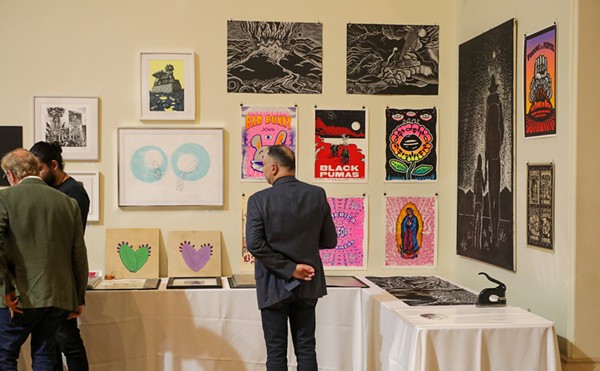Whether by necessity or desire, the selection of artwork from the AT&T Collection on view in the McNay’s Stieren exhibition wing makes for an incisive monograph on painting’s development in the ’80s and early ’90s, when it was still recovering from the suffocating grip of Abstract Expressionism’s titans and Donald Judd’s brutal eulogy. It’s a tale of developments that happened largely out of the spotlight, before the third-world-GNP prices, hedonistic art fairs, and media overexposure that have come to characterize art in the age of celebrity.
You’ll find photo-realism represented by a plaintive Robert Bechtle canvas that doubles as a commentary on the somehow reassuring banality of Western American suburbia. Neo-classical and Pop variations on the resurrection of the figure and portraiture can be studied in David Ligare’s “Seated Woman” and Alex Katz’s “The Red Dance,” respectively. Perhaps you pine for mixed-media assemblage and 3-D painting with strange and salvaged objects? You’ll find both an earthy abstraction by Cesar Martinez and a trippy Pop collage by Tony Berlant.
We’d be into the aughts before painting made a full-on comeback, aided by commercial art, animation, and the digital revolution. But the clues to its resurgence can be found in the exhibition’s best pieces, including James Rosenquist’s “Telephone Explosion,” which shows off his wickedly sharp take on collage filtered through our ad-saturated environment (is that man working with digital billboards yet?); an Al Held canvas that wraps a Judd-straight scaffolding in unruly, exuberant Dr. Seuss ribbons (oh, the places you’ll go!); and Yvonne Jacquette’s “Triboro Triptych at Night,” which squeezes abstract color and movement into a dark grid for a bird’s-eye view that invokes that near-spiritual feeling of circling the big city in a quiet airplane cabin.
Paul Wonner’s “To Flora” (1985), a surreally pristine yet deeply moving still life, is especially interesting as a reflection of the Reagan-era Zeitgeist. Cut flowers in vases, jars, and pots surround a table upon which a small book is open to Rembrandt’s “Saskia as Flora," Roman goddess of fertility, flowers, and spring — an overt nod to one of the artist’s inspirations. Maybe it’s just my mood in the wake of recent deaths in our art community, but the work feels like a (AIDS-era?) memento mori.
Wonner was a member of the Bay Area Figurative Movement, which included such illustrious refugees from Abstract Expressionism as Richard Diebenkorn and Wayne Thiebaud; fortunately, the McNay’s permanent collection includes his earlier, lovely work “Seven Views of the Model With Flowers” (1962) (on view in the Frost gallery), allowing you to observe one painter’s evolution to a thoroughly contemporary style.
But mostly these canvases struggle to distance themselves from their legacies, even when the result is pretty grand on its own terms (i.e. John Alexander’s “Feathering the Cultural Nest”), and essential parts of the conversation are missing — notably Basquiat’s combative Neo-expressionism and Schnabel’s “look-at-me” hunt for fame and fortune.
More than 60 percent of the show is comprised of paintings from the ’80s and ’90s, but among those that fall just outside those artificial parameters is Joseph Raffael’s “Wild Iris,” in which the artist renders a field flower’s elemental unruliness with just enough abstraction to convey unkempt emotion without losing individual detail. His use of nature’s unschooled palette framed by whites finds its match at the San Antonio Museum of Art, where Marcia Gygli King’s beautiful “Botanical Paintings” are on view in the downstairs gallery.
King successfully borrows from previous masters of the floral, starting with the Dutch, and continuing on through 19th-century botanical engravings, Van Gogh, and O’Keeffe, fashioning these appropriated elements — extreme close-ups, color fetish, articulated leaves — into her own language. Her “once-removed painting” process, in which she creates a print by pressing the canvas against painted plexiglass and then continues to work on the painting, creates a subtly textured finish that absorbs light, heightening the dramatic, yet somehow clinical, contrast of dark and bright. Against this bloodless lead-white and charcoal-black backdrop, the startling daubs of vermilion, madder, and ochre turn her objects into vaguely unsettling subjects — like so much Elizabethan nobility — who look as if they might very well rule a secret universe of ruthless
passion, personal subjugation, and fleeting
happiness. •
VISUAL ART
American Concepts and Global Visions: Contemporary Paintings and Sculpture
Through May 17
McNay Art Museum
Mcnayart.org
Also on view: Masterworks of Photography
Marcia Gygli King: Botanical paintings
Through Apr 12
San Antonio Museum of Art
Samuseum.org
Also on view: Marcia Gygli King at Southwest School of Art & Craft (swschool.org) and the UTSA Gallery (utsa.edu/arts)





